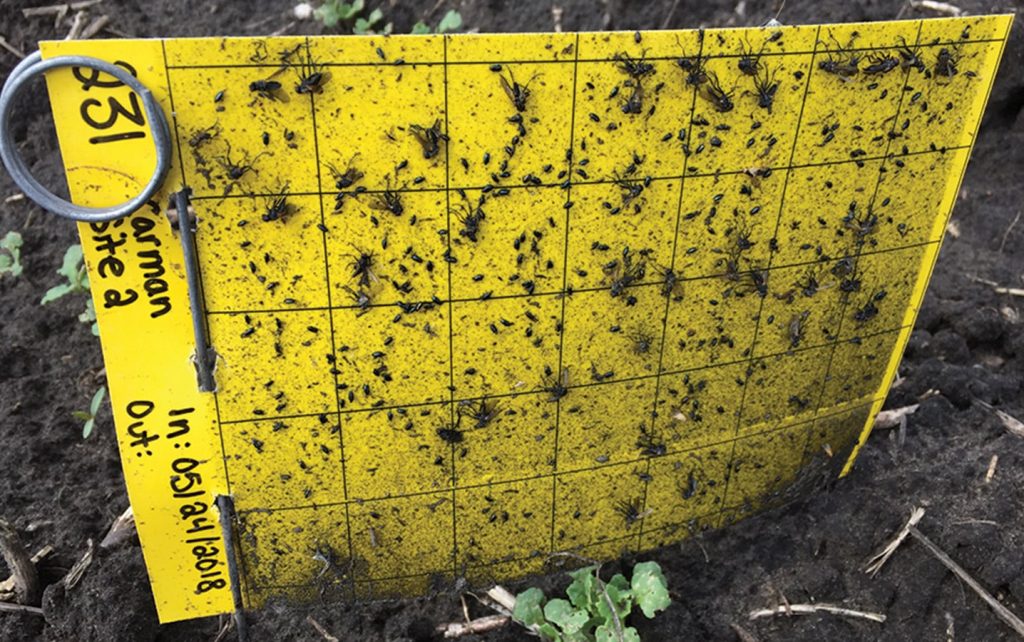Tips for a more integrated approach to flea beetle control
KEY RESULT:
This study validated the nominal economic threshold of 25 per cent defoliation. It also determined significant associations between landscape structure and flea beetle abundance, weather and flea beetle abundance, and plant density and flea beetle damage. As well, two flea beetle predators were confirmed.
PROJECT TITLE, PRINCIPAL INVESTIGATOR:
“Integrated approaches for flea beetle control – economic thresholds, prediction models, landscape effects, and natural enemies,” Alejandro Costamagna, University of Manitoba
FUNDING:
AAFC Agri-Science Project, Alberta
Canola, SaskCanola and Manitoba
Canola Growers
Flea beetles are a major insect pest, threatening the establishment of canola by feeding on emerging seedlings. This project aims to investigate natural enemies impacting crucifer (Phyllotreta cruciferae) and striped (P. striolata) flea beetle populations, identify landscape features promoting effective natural enemies, develop models for flea beetle populations based on weather and crop variables to provide timely prediction of the flea beetle population, and to determine a nominal threshold for flea beetles in canola.
Through 2015-17, researchers conducted 41 economic threshold field trials, sampled 78 grower fields to investigate landscape features promoting effective natural enemies and lower infestation levels, and made 563 observations at 71 locations to develop predictive models for flea beetle populations based on weather and crop variables. In addition, laboratory work was conducted to develop molecular tools to identify predators that impact flea beetle populations.
KEY RESULTS:
- Analyses suggest that the nominal economic threshold of 25 per cent is correct, pending further replication in the final year of the project. The study also observed that neonicotinoid seed treatment produced the highest numerical yield in the early-seeded trials. Applying foliar insecticide also provided some yield protection compared to the plots without control measures.
- The lab study found primers to identify striped and crucifer flea beetle DNA in the gut contents of insect predators. These primers were used to assess which insects may be predating on striped or crucifer flea beetles. Two carabid (ground) beetles – Pterosticus melanarius and Amara torrida – were found to attack flea beetles. Management strategies that increase the population of these ground beetles could help reduce flea beetle populations in growers’ fields.
- Significant relationships between flea beetle abundance, plant density and canola damage were determined. This can guide growers to increase flea beetle monitoring in higher risk areas. The percentage defoliation generally increased with the greater number of flea beetles. It was also found that the defoliation never exceeded the nominal threshold of 25 per cent, which either suggests that seed treatments gave adequate protection against flea beetles or that flea beetle abundance was not high enough to cause economic damage. The negative interaction between the number of plants and the number of flea beetles implies that varying plant densities would produce different amounts of defoliation for the same number of flea beetles. While plant density is important in determining of flea beetle economic thresholds, more analysis and investigation is required to provide recommendations on the ideal plant density to reduce to best manage flea beetle damage.
Weather effect on striped flea beetle:
Regarding weather impacts, a warmer April and May, a cooler and wetter June, and accelerated plant growth were positively correlated with greater spring striped flea beetle populations. May had the most impact temperature-wise, as warmer temperatures signaled larger beetle pressure whereas cooler temperatures signaled lower beetle pressure. However, striped beetle pressure in the spring did not mean they wouldn’t be active in the summer.

Weather effect on crucifer flea beetle:
More rainy days in May and June were positively correlated with spring crucifer flea beetles populations, although too much rain in June had a negative impact. Warmer Mays were positively correlated with higher spring crucifer populations. Low crucifer pressure in the spring also seemed to show low probability of crucifer populations in the summer.
Researchers did note, however, that modelling using only weather data was difficult because there were instances where locations less than 20 km apart (which had the same weather) reported different flea beetle patterns.





